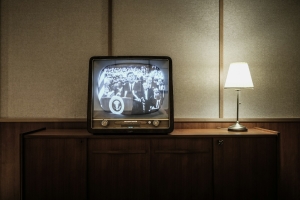Leveraging Traditional Media: A Comprehensive PR Strategy for Established Brands
Get Started
Call-to-action
Tel: (+234) 802 320 0801, (+234) 807 576 5799
Email: info@Stonehillresearch.com
Office Address: 5, Ishola Bello Close, Iyalla Off Street, Alausa, Ikeja, Lagos, Nigeria
Introduction
It is also commonly, and perhaps accurately in some cases, referred to as ‘old media’. Traditional mass communication – also known as mass media relates to past methodologies of mass communication that existed prior to the emergence of the internet. For the most part, these are approaches that result in one-way communication where the producers communicate information to the audiences.
Constants of these types of channels include the print press, television and radio, and the billboard advertising. It has often been purposely designed and structured to such extent as to transmit such informational messaging to the public and has in the past served as an important medium of mass communication, entertainment, and marketing. The traditional media works within predetermined formats and systems, which makes it possible to produce and disseminate news content under certain editorial governance and principles. And in this regard, unlike the face-to-face digital media that allow for the exchange of views and feedback at the same time, traditional media is done in a sequence, which is the creation of the content, planning the time of its realization and then the actual execution. The traditional media continues to play a vital role in all public relations activities, strategies and practices, providing a great amount of media space and trustworthy sources for communication of corporate messages. The different types of traditional mass media and the audience demographics associated with these mass media are important in allowing any dominant players in the market to access their consumers effectively. This may assist them in nurturing the good relations with such businesses and improve the public image for such businesses.
Traditional media refers to methods of communication that were available before the age of the internet which includes print like (newspapers, magazines), Broadcasting (television, radio) and out of home advertising (billboards, transit ads).
Contours of on-going growth and development of communications outline traditional area media as one of the elements of complete moderation which allows using effective dormant marketing tools Traditional and Social Relations of communication. The specificities of the diverse types of classical mass media help well established corporations to better reach and interact with pp. In turn, this helps in establishing healthy contacts and increasing the image. Even with all the new advances in digital communication, one cannot deny the strong influence of other media in storytelling and advertising. Thus, conventional forms of advertising are still needed to attract a variety of target groups and above all, create brand trust.
According to many consumers, more often than not, they prefer traditional media than social media as information sources which, to them, appear to be credible.
Traditional media explains a physical presence and, in most cases, can be useful in increasing the perceived authenticity of the brand in relation with physicians marketing among established players in the market. Other examples of traditional media are all forms of communication which were devised prior to the use of internet such as advertisements in newspapers or periodicals, broadcast television and radio or outdoor advertising such as billboards or transit ads.
Types of Traditional Media
Print Media.
Newspapers: These are printed materials that are published constantly or at regular intervals covering events happening in the area, country and the world. Many a time a newspaper will have sections covering politics, business, lifestyle, opinion, and many other sectors thus serving as a great source on reports and the people’s opinion and participation.
Magazines: This is another form of printed media that is issued on weekly, monthly or quarterly basis but however focuses on one issue such as beauty, information and lifestyle. Magazines usually have narrow focused audiences and present editors with possibilities of running stories, selling advertisements, and writing long features.
Brochures and Flyers: These are great marketing materials that are used to again introduce or provide short information about a company, product or an event. Most of these are given out to people by hand or are placed in public areas.
Broadcast Media.
Television: This is one of the mass communication channels that presents information in audio j and visual forms in a bid to capture many viewers. Various genres such as news, talk shows, documentaries and other ads can be incorporated into TV broadcasting which makes it suitable to advertise a brand.
Radio: This is a communication medium that involves sound only and transfers information in both live and recorded strategies, radio reaches people via news, music, talk shows, and advertisements. Radio provides an interesting platform to appeal to the audience especially locals during their busy hours moving about or watching programs orientated towards the members of the public.
Outdoor Media.
Billboards: These refer to enormous massive marketing signs placed in busy areas of a city enabling businesses to stand out.
Typically, these advertisements feature very limited text or pictures which tend to grasp people’s attention in a very short time.
Images on the Rail: Posters placed in the inside spaces of passenger trains including the back and the side of train seats. This type of advertising is aimed at people who spend time in the travel mode and therefore allows reaching different customers with high volumes.
Flyers & Posters: Advertising materials that are pasted without restriction, at visually conspicuous places, drawing attention to events, goods or services. These objects are located in shops, school gyms and outside.
Specialty Media
Mail As a Form of Advertising: Sending brochures, postcards or other pamphlets to advertise the goods and services to clients via mail. This kind of advertising provides great prospects in using the psychology of the defined masses.
Sponsorship by the Corporates: Events help increase the visibility of brands; thus, corporate companies embark on event sponsorship (sports, concerts, community gatherings) to demonstrate their corporate social responsibility. For individual companies also the advertising of the event can be performed through the use of event media.
Objective of the PR Strategy
Enhance Brand Awareness
The strategy focuses on extending the brand awareness in the important regions by means of appropriate media sharing so that the brand remains to be foremost within consumers` reach. Understanding the needs professed by the audiences, they Media also help break through the barrier to the audiences that would be dissociated with the digital content even further. Build and maintain a goodwill image of the Brand PR is able to shape the brand perception in a way that helps create a positive authoritative business image among other industry players. This strategy tends to active-led media approach, in which the media is being featured with all the brand glory, impressive activities, and socially responsible practices.
Foster Relationships with Key Stakeholders Exposure in traditional media allows an opportunity to contact journalists, experts and opinion leaders who are willing to spread the required information about the Brand Many of these relations can also eventually lead into press publications, thereby improving the brand’s image in the long run.
Addressing the Media shift as consumer tastes change, so do the communication methodologies to these brands and therefore the need to marry the old fashion media with the new media. That’s how the two of them would work, plain and simple. Scope of the Strategy Target Audience Identification The task of who exactly should a brand focus upon becomes fundamental.
This strategy will explore audience segmentation in order to configure messages in a more suitable way.
Scope of the Strategy
Total Coverage
The strategy will consider each element of PR: work with the medias, preparation of content, crisis management, understanding the results enhancing the use of traditional media.
Future Foresight
Highlighting sustainability and further work within the community, the strategy leads the brands to consider PR as a process and not tied to any particular campaign which helps them remain relevant over time.
By orienting the PR strategy around the role of the traditional media and the importance of this media for any major brand, major brands will be able to function in emerging markets’ media environments and reach their audiences.
PR Strategy for Established Brands Key Sections
Media Relations: How to Engage Journalists and Editors
Investigate and Pinpoint Essential Media Interlocutors
Analyzing the Media Environment
Carry out research to find suitable media channels for the brand image or personal image in terms of specific geography and the marketing industry. This comprises local, regional and national publications in newspapers, magazines, radio channels and television channels.
Search for journalists, and editors using industry guides, media publications, the Internet (Cision, Meltwater) and social networking sites (LinkedIn, Twitter).
Creating a Targeted Media List
Prepare a detailed media contact sheet with appropriate name, designation, contact details, and deep expertise handling all the journalists and editors created by the organization.
Clusters these contacts based on the level of power, extent of readership, and how pertinent these are to the goals of the corporation in order to assist in targeted outreach.
Tracking Media Trends
Seek to know what areas are not only popular to the media, but also the issues which journalists would prioritize in their articles. Knowing the hot subjects helps to create worthwhile ideas and network around common topics.
Craft Personalized Pitches
How Journalists Think and Act
Look up other journalists’ articles to see how they are written, what journalists write about, understand what appeals to journalists and the styles of articles. This insight will guide the efforts made to address journalists.
Observe their work habits and tone as well as common clichés to adjust the nature of the proposals to their disposition.
Tailoring Your Message Craft customized pitches in a manner that speaks to each particular journalist’s proportionate audience. Explain why is it now or when the story is more significant and relevant to their work than at other times. Sit in vengeance as they call it the day of their funeral day. Add juicy stories but incorporate various angles which actually relate to how the subject differs from others showing more of how the brand looks at the story and what it is adding to the issue.
Clear and Compelling Subject Lines Use and include interesting lines that make the readers want to read the email more often than not. Most of the time, if the subject line is compelling enough, there is a high chance that the placed pitch will not be ignored and will be opened by the recipients.
Avoid using technical terms while also ensuring the story that is outlined is straight to the point. Follow-Up Strategies There is no need for clients when no response is received to the authors pursuing measures on the pursued measure for no more submission reasons than after a week, one will wish to hear from the journalist or media conduit How likely are people to follow that does not mean that he is slack and too pushy.
When asked, do provide more information the journalist requires or ask for his/her interviews or other assets for the implementation of the assigned project that you got interested in. Foster Ongoing Relationships Regular Communication Develop rational protocols for keeping in touch with the needed media people updating them about the brand and its activities, useful events, and interesting information in advance and on a regular basis. If not pitching a story, send interesting facts, quotes from experts or news about the industry that might be useful for them. Social Media Engagement Journalists and editors should be connected on social media and interaction with posts should be done.
Share their articles, comment on their posts and involve in discussions for rapport building. Join Twitter to actively participate in trending conversations in a bid to enhance the relationship further. Organizing Media Briefings Organize informal meetings with journalists or arrange round table media interactions to help them get familiar with the brand, the things the brand does and the industry, including recent developments. This creates a sort of ‘togetherness’. Provide an opportunity for brand representatives to respond to questions from journalists. This always guarantees that the knowledgably crafty social window will be able to cover the story. Sending Personalized Thank You Notes As a way of appreciating the journalist’s efforts after analytical perspectives of the story or an interview, a personalized appreciation message is sent to the journalist. Their coverage could be acknowledged by sharing it on social networks or via the social media pages of the brand and additional partnerships reinforcing the goodwill of their relationships for the aim of prospective collaborations. Media Lists and Tools Utilizing PR Tools Consider subscriptions to PR instruments that could help with monitoring media, managing databases, and evaluating. Pursuant tools such as Cision, Meltwater, belly Prowly could enable the Jim Beam’s efficiency outreach with terrain relations’ activities. Attach relevant and media measurement information selection and outcomes. Creating a Centralized Database Keep in one place media contacts along with the history of interactions, preferences and other notes about previous communication.
This helps in ensuring outreach which is coherent and well placed to the target audience. Update the database as often as new media personnel or outlets are added or lost, so that there are no unnecessary gaps in the brand’s communications. Assessing Media Relations Performance On a continuous basis, review the results of media relations efforts by determining the percentage of responses to the pitched stories, the amount of coverage received, or positive, negative and neutral sentiments. Use this data to determine which outreach strategies to use when evaluating how to build relationships and gain coverage for the target brand.
Developing comprehensive media relations is critical to the successful use of traditional media. More and more established brands are building relationships with journalists and editors, conducting research on contacts, pitching them, maintaining connections, and using proper arguments. It brings a greater brand’s awareness but at the same time creates a healthy media environment that allows the brand to develop over a long time.
Press Campaigns: Drafting Press Releases for the Print and Outdoor
Requirements of Composition: Possible Technical Styles and Design Styles of Press Release
Basic Structure: Main Headline Appearing on the First Page
Top with an exact and catchy title that captures the essence of the information in the press release. The title needs to have a quite short length, be catchy and informative in order to draw the attention of the reader upon the announcement in question.
The subheading appearing directly below the headline (if any). This leads to enhancing the main headline, which however plays a crucial role in advertising the main point on its own without explanation.
Dateline
The only advice here would be to include the dateline within the first paragraph showing the city state and month day and year as the first doing example inside quotation marks, ‘New York City, NY. October 10, 2024.’ It is important to take note of this information as it helps to establish the geographical and the temporal relevance of the story or news being reported.
The lead paragraph is critical because it guts out the grain of the news and ideally gets who, what, when, where, why, and how squared away in a nutshell. It should state in a captivating manner the gist of the news as one would want the audience to not ignore their writing.
Put the after most essential information first therefore – the core idea must be clearly communicated regardless of being placed in near to the end of the release.
Middle Section of the White Paper. The Structure of the Paper Look Like Inverted Pyramid. First Present the Key Information After that Supporting Information Comes. Also, Attach Background Information, Figure, and Context Which Makes the Story Matter.
To make the point clearer consider the rule of dividing the text into smaller parts for example two or three sentences in one paragraph and use lists when necessary for better continuity of ideas.
Quotes
Apply quotations from the most meaningful persons eg, Executives, experts or customers.
These quotes should provide insight and add a human element to the announcement, including quotes accentuating the point of the announcement and where the audience is expected to understand the announcement from the point of view of the quote given. Quotes should be relevant and provide a fresh perspective on the information being announced and which the people will be interested in.
Format: Boilerplate The final paragraph of a press release in this case about the organization and its overarching activities covers the range of issues and is often called a boilerplate. This paragraph should be standard in every press release. Add a sample of how your organization looks on papers including contact details to be used by the media.
Communications: Constructing Engaging Content: Using Clear Language Communicate clearly and effectively and ensure that the target population is able to understand the message.
Do not use any vague, complicated, or technical words which may confuse the reader.
Active voice should be used to create clarity of who undertook the actions within the content Emphasis of: Highlighting the Newsworthiness Give reasons as to why there was the need to make the announcement else people other people may look at the announcement as plain and dry. To answer the question of so what: indicate why this news is important and what it means to the various stakeholders. Incorporating Multimedia Elements Throughout the press release, encourage hyperlinks to be included to high resolution images, videos, maps, and audio sources that are relevant to the story.
Highlight images with appropriate captions and attribution for the images used, also properly organizing the multimedia material related to the announcement, making sure it is appropriate and attempts to be professional regarding all submitted materials
Press Release Structure and Necessary Elements.
Ethics In Marketing Communications Procedures
Each press release should be search-engine optimized by including the phrases and words pop media quotes Readers of potential times will use. This is possessive visibility in online searches.
Adding links to the company website or to other relevant knowledge increases the value of the release and pushes traffic to it. Disposition of the Running Strategy. Channels selection for distribution. The target audience and nature of the announcement will guide the choice of the distribution channels. These may include using example one line nova services focus on PR newswire and business wire in PR or even emails to journalists or posting on the company’s gallery or website directly.
Look for websites such as these within the industry or region expecting to publish such news. Selecting the appropriate time to publish. Organizing the press release in time to release it on news channels, or within the audience, or during specific events. Weekends or public holidays should be avoided as there will be a lower amount of media coverage. If there is, it is wise to restrict the release of the timely news to specific journalists who have been clearly informed about the news. Direct Contact to Journalists. Submit the press release and contact the journalists and editors who would be most interested.
Tailor these messages to the audience to maximize chances of being covered by the news. Extract the Key message of the press release in the email text, addressing it to the relevance of the journalist’s scope. Follow-Up Communicating with Journalists after the Release If any, please inform a journalist in charge who is likely to be interested in the release after the material has been sent out. Understand their schedules very well, early or timely and polite reminders can go a long way in building good relations and prompting news coverage.
Monitoring the Press Release Coverage Leverage press coverage analytics to measure the Impact of the press release. This helps assess the success and also targets new opportunities for further engagement. Examine how the news has been covered and determine how the public/ media is favorable towards it. Evaluating Performance After the campaign ends, analyze the statistics around media impressions, placements or articles, and audience response in order to evaluate the campaign intended by the press release. Make it easy to answer these specific questions with the reiteration of quarterly and yearly communication and performance including press release techniques and angles made a difference. Communicating through the traditional media requires effective writing of press releases as an important component for the accomplishment of the brand communication objectives.
Certain techniques, such as adhering to a polished style, stressing on providing enjoyable contents, utilizing reaching strategies, and pursuing the journalists, could also increase the presence of established brands and ensure that their tales are shared appropriately. A press release enhances the communication process but also assists in the establishment of relations with the media and the promotion of the company within the market.
Broadcast Engagement in the Communication Making Use of Television and Radio
Pinpointing Areas of Potential
Identifying Proper Programs
Find foreign, national and local television and radio programs which fit with the brand’s stance and the target demographic. In this category, fall news shows, talk shows, morning shows, or any other specific theme-based broadcasts.
Think about various types of content, such as interviews, panel discussions, sponsored sections, etc., where the brand can participate and gain exposure.
Targeting Important Time Frames
Find out when various programs are scheduled and what the target audience for these programs is. Look for the optimum times or morning programs which draw a larger audience.
Assess the coverage of the program in terms of ratings and audience engagement so as to know where the bulk of the attempts should be focused.
Studying Competitive Coverage
Follow how the competition uses the broadcast media. Find out where they appeared, what topics they discussed, what formats they used to discover ways and means of doing it differently.
Keep abreast of the developments in your industry to prevent any possibility of your brand communication becoming stale.
Getting Ready for Media Interactions
Media Training for Company Representatives
In-depth media training for people who will be interviewed on behalf of the brand should be offered. This training should include good communication skills, body language, and how to deal with odd balls.
Conduct mock interviews in order to enable spokespeople to practice the important messages they ought to deliver more convincingly in real situations.
Developing Key Messages
Define tombstone style key messages which should be conveyed by the spokespersons with particular reference to the images delivered in the course. These messages also should be in line with the overall story of the brand and the audience too has such an information.
Prepare facts and figures which are required to support these messages and ensure that these are plausible so that spokespeople are able to answer questions in an informative way.
Creating a Media Briefing Document
Draft a media pitching document that briefs on specific important facts about the brand all news and what to discuss or not to discuss. This should be a reference for the spokespeople before and even during the interview session.
Let them also include the profile of the related team members and their clients praising their services along with the modern day as well as past industry practices for discussion.
Creating Engaging Content
Developing Story Ideas
Search for interesting stories that are able to draw in the current trends or the audience’s interest. Such may include the launching of a new brand, the relaying of the achievements’ stories, and the discussion of the problems faced by the industry as well as steps taken to address those problems.
Organize innovative strategies on how to tell market the brand using stories that are interesting to the audience ranging from human beings to non – living things.
Visual and Audio Elements
Create captivating visuals that can be included in the visual space provided or improve the existing story through product demonstration, infographics and shooting on location. Prepare those materials as you would any other visuals for television. Prepare those for radio as follows: find clips, take interviews, make use of jingles that leave a lasting impression on the listener. Always make sure that there are also audio components and that they are presented in a professionally prepared manner. Using Testimonials and Case Studies Include a valid customer testimonial or case studies showing the effectiveness of the brand. They serve as real-life examples that bolster the target audience’s faith in the brand. It is important to brief the customers or clients to appear in the interview and make comments that will help understand them better.
Post-Engagement Strategies Amplifying Coverage through social media Following such an interview, publish the segment on the brand’s active social media pages and website as well as e-mail newsletters. This enforces the messages and expands the limit of the content. Also include the media outlet together with the journalists who were part of the story in order to create goodwill and foster relationships. Monitoring Audience Engagement Assess how the audience reacted to the program and if they engaged the content and material in terms of their appearances to the elsewhere mentioned broadcasts. This could include social media activity, website analytics, and reactions from the viewing audience. Gauge sentiments from the audience and reactions that follow the message to assess the effectiveness of the message and areas of improvement.
Thanking Media Contacts, it is also thoughtful to thank a journalist and/or a corresponding producer after conducting an interview or making an appearance.
Thank the reporter for the chance to tell the story and summarize any unique audience interaction, which would be valuable from a customer care perspective in the segment.
Fostering relationships with the media professionals can help in securing new business deals or projects in the future.
Evaluation of Results
Media coverage metric
Consider the analysis that takes into account the coverage that was done in terms of level of penetration, size of audience and their overall sentiments towards the coverage. Relate the appearance to the objective that had been set out prior to the engagement.
Consider the metrics on the number of people who watched the broadcast media, the number of people who listened to the broadcast and other related audience measures and use those to measure the effect the broadcast media had.
Measurement of Message Impact
Request for viewers response through conducting a follow-up or feedback from the audience to assess message impact. This may help to ascertain how the key messages were articulated and how well the messages were comprehended by the target audience.
Make an assessment of whether there was an upsurge in brand calls made, increases in website visits and activities on the social media after the news as seen on television was aired.
Constancy of purpose
Make use of all information collected in the evaluation of impact for the improvement of engagement with the television and radio in future coverings to reduce chances of enjoying screens effectively in future sessions.
Be quick, looking for new places to engage with the broadcasting, integrating with the changing environment of the media, and the will of the target audience.
Making optimal use of television and radio with respect to increasing brand awareness is logocentric and narrows audience engagement and message reinforcement.
Through the effective identification of relevant programs, the adequate training of spokespeople, the development of appealing content as well as the execution of programs with the ability to measure impact, the grown organizations have been able to extend their reach in the broadcast market. Such activities not only enhance credibility above board but enhance the relationships with the target audience, which in turn helps to promote the brand and ensure successful outcomes.
Civic Engagement: Mobilizing Relations with the People by Conducting Events and Sponsorships
Planning Community Events Identifying Community Needs and Interests Curious about the interests and needs of the local community? Conduct surveys, focus groups, or community meetings. This enables fitting the new events into the existing culture of the community. Building Relationships with Local Organizations Engage with schools, local active, or non-profit organizations to help understand the event better and build connections that would be beneficial in executing the event.
Attach Types of Events to Identify for Carrying Out the Event Provide for different types of events such as stork workshops, awareness courses, medical camps, family funfairs, or fundraising for some good cause, on the typology of the ethnos of the community of disposition. Each type has different audiences and possibilities to attract attention. Getting fresh people in-house can be achieved by various ways The audience. Equate Exploration Activities In two steps define the specific objectives of the event such as building up brand awareness, building up community relations, or increasing awareness in on a particular issue. Goal setting will enhance decision making and also execution about preparing and monitoring work progress. Define expectations in the short term and long term. For instance, interaction with the community, level of emergence, and mobility daily, as brand loyalty over time. Planning for Event Construction by Logistics Develop and write down the Event Description that shall include some operational issues of why and where a gathering shall happen and what manpower and finances may be needed. The venue should be adequate to accommodate as many people from the society as possible. Make a schedule with a list of all the activities which must be completed in order from the first step, through all the stages up to the last one which is the follow up after the event.
Distribute responsibilities in such a way to enhance coordination amongst team members.
Funding.
Finding Events that are Ready to be Sponsored.
Seek out activities within the community that serve the mission and values of the brand, for example, sports events, cultural events, charity walks or educational activities.
Review these events in terms of the target audience to ensure that the events are appealing to the target consumer of the brand.
Sponsorship Promotion Package.
Create mutually beneficial sponsorship promotion packages which cater for both the brand and the event. What this entails may include provisions for advertisement, provision of promotional literature, and exposure at the place.
Divide the sponsorship into different categories, so as to make it possible for different users according to their financial capacity and also increase the size of a potential business or even a larger one.
Establishing Partner Relationships.
Work with event organizers for potential win-win situations. Through this partnership, the event can be more successful and the brand gets more exposure.
Think about sharing the hosting of events or initiatives that can enhance the connection of communities in relation to the brand.
Using Sponsorships the Right Way.
For improved exposure consider using banners, handouts, announcement at the events, etc. Including promotional materials such as take aways or sampling may enhance the attendance of visitors.
Take an active role during meetings and discussions especially about the brand so that you can facilitate brand promotion.
Building Relationships with The Local Community.
Working With Other Local Enterprises and Institutions.
To increase the effectiveness of the existing community programs, join forces with local businesses, and civic and educational institutions.
Shared practices can enhance the efficiency of resource utilization and broaden target demographics.
Develop a consortium of regional allies who will assist with marketing and hosting events to boost the number of participants.
Setting up a community consultation body
Bring people together with local actors such as leaders and residents to make a community advisory board that will involve the process of community initiatives.
This board will be helpful in court planning events, identifying the needs of the community, and fostering good relationships with the community through participation.
Working with Grass Root Renowned People
Seek out local advocates or thought leaders in connection with the brand who can further enhance the event or any initiatives. Their support helps in reaching a wide population as well as growing the brand’s trust.
Work with such individuals to produce capital content or experience regarding the activities and events to do with the community and its development needs.
Evaluating the effects on the Community
Establishing Important Performance Indicators or KPI
Establish precise indicators for evaluating the effectiveness of activities aimed at community involvement. Such KPIs may include the number of people who attended events, the number and nature of comments made by participants, the volume of social media interactions, or coverage from the media.
Identify and define evaluation indicators that will help measure and evaluate the effectiveness of the communities’ activities both within quantitative and qualitative perspectives.
Redistributing Information
Seek information from the event attendees through conducting surveys, interviewing individuals, or even casual talks. This knowledge will be useful in determining the achievements of the event and its shortcomings.
Promoting an active interaction with the people to appreciate possible ideas on the brand and its goals.
Assessing Brand’s Image
Measure any shift in the perceptions of the brand after participation in community activities. This may include measuring social media, doing some follow-up interviews, or media monitoring.
Ascertain if community projects made customers more attached, more attentive or more positively inclined toward the brand.
Outcome Evaluation
Provide the reports which will summarize the results of community events and sponsorship, incorporating key figures, feedback, and overall results. Distribute such reports to stakeholders, partners and the public.
Website, social media and printed materials filled with success stories, quotes, stories or other information when the brand positively transfers activities to the society.
After the Event
Appreciating Attendees and Collaborators
Thank you notes via messages or emails are necessary especially to the participants, various sponsors and any other partners who are crucial to the fulfillment of the event. Thank them for the participation and the support.
With due course, provide summaries of the mass media mentions and articles focusing on the event COVID-19.
Post-event Communication
After the event, avoid wasting time notifying them with a few thank you emails but instead keep them on board such as via newsletters, social media posts, or any other relevant communication methods. This ensures that the brand is fresh in their minds and helps consolidate the relationships.
Disseminate findings and insights from the event to the public to enable them to appreciate the worth of the event.
Developing New Projects
Implement the suggestions and ideas gained during the course of this exercise to advance community participation in the next phases.
Identify positive aspects for duplication and determine active areas of improvement.
Be attentive to any advancement in community interests and needs and craft new initiatives as required in order to remain relevant and impactful.
Conducting events and sponsorships is an effective approach for existing brands to build valuable relationships with people in the communities in which they operate. With proper planning of the initiatives, engaging local stakeholders, evaluating efforts, and sustaining interaction, brands can attract attention, strengthen connection with the communities and earn loyalty. These activities are helpful in achieving brand goals and also help in actual improvement of the community which is good for the brand and its stakeholders.
Crisis Communication: Historical Principles of Media Training and Readiness
A Look into Crisis Management
A crisis may be regarded as any occurrence that is if certain lends itself to poor handling or over-substantiating delegitimizes the effort, organization or brand. This includes unforeseen events such as product recalls, legal matters, negative media attention, accidents, or any other factors that may raise public ire.
Understanding the various categories of crisis and the level of impact these can have on the brand is imperative in ensuring effective preparedness to incidences.
Preparedness, On the Other Hand, Is Vital
In short, the enhancement of reputation damage can be achieved by resorting to previously accomplished crisis management planning processes and implementation measures without wasting time. Notably, the degree of planned actions should be related to the estimated, positioned danger level of such crisis situation. This is where the IAP comes to the picture.
Preparedness is the willingness to develop contingency plans for addressing various crises even before they occur.
Crisis Communication Plan Development Tips: Developing a Crisis Communication Team
Create a crisis communication team with appropriate members from the PR and legal advisers, some managers and PR personnel. It will be this team that they will be tasked to lead the heavy lifting of the crisis management efforts. This team should be individually accountable for the tasks undertaken in that crisis management procedures so that there is no overlap of activities that could delay the planned objectives from being achieved on time.
Crisis Communication Plan: Drafting A Crisis Communication Plan
Make and communicate the priorities that will be projected that will include making effective communication and the ways of dealing with information such as the media to be used and where appropriate by whom. Identify collected information which audience received it including alternative ways of disseminating involved audience.
Formulating a Chronology of Actions This subsection develops a timeline that identifies the actions taken during the initial phase of the crisis and the long-term objectives such as communication, recovery planning, and more However the timeframe developed should be adequate to the force of problems at hand. Providing Press and Media Training for Spokespersons Identifying the Appropriate Spokespersons Pick the right spokespeople who have the right levels of knowledge that pertain to the firm or the situation and that can be able to represent the brand even in times of crisis. This could be executives, public relations practitioners, or section authorities. Provide They require that the emerged spokesperson understands the importance of the crisis communication plans and more importantly will follow them.
Organizing and Implementing Media Training Provide effective media training including content such as clear and effective speaking and listening, delivering the message, and asking the questions where and when appropriate. Respect the standard that includes performing simulated crises for the spokespersons where they will bear the strain of the interviews and crisis scouting. Imparting Essential Messages to Spokespersons Help and encourage the spokespeople to impart necessary messages to the arms of the media and the public to ensure that they do not discourage nor pretend to take a defensive stance towards the issues of the crisis. This involves accepting the existence of a crisis and the need to address it. Move the spokespeople to actively listen during interviews and respond accordingly to reporter’s inquiries.
Fostering Communicative Action under Periods of Crisis Augmenting Critical and Constructive Messages The image of an organization beneficially contributes to its accomplishment. Clear Messages. However, the strategy previously devised must but be reasonable to the extent of the situation. The tendency to define the issue at hand.
Improve Organizational Control. Move and maintain consistent messaging during the entire period of dealing with the crisis through the spokespeople in a manner that assumes none of the involve sides are offensive or defensive. Addressing Basic Issues. Getting all strengthens in the internal crisis management policy communication especially reaching out to junior levels within the organizations.
However, there are elder barbarism who resort to amputation of a limb considering unreconstructable the heals and trauma incurred by the disease, even though all odds accumulated over the years would overcome such grievous disability in competence and chances of comeback. Communication is a core function within complex organizations, and management particularly at national headquarters cannot maintain control, compulsively enforce uniformity in discourses, meanings and practices amongst the operating units on the broad national territory.
Craft a clear stance regarding the crisis and exhibit the organization’s readiness to address the issues. Also, such messaging should be avoided across different communication bases in order to prevent confusion and mixed signals. Using Various Channels of Communication Imagine the use of other important channels that will help get the message across including they can use press releases, social networks, the website among others and direct interaction with stakeholders. Think about who the message is aimed at, and communicate each message/channel accordingly. Ensure that the message is simple for the targeted audience. Frequent Communication and Openness It is essential to regularly communicate to the stakeholders like customers, the media, employees, etc about the developments of the situation and any action being taken in relation to the situation. In this point it is important to maintain the communication between crisis management team and stakeholders even if there is uneasy communication. Known limitations and even admitting looking communication credibility. Recommendation on Past and Post Crisis Recovery and an assessment of communication effectiveness with regard to forging reconciliation with the stakeholders as well as media and the community at large. How to do a Post Crisis Review Several months later after the crisis has elapsed, detailed investigation of the crisis response will be performed in-chapter only focusing on what went well and what could improve. Form discussions with team members and other parties who worked during the crisis management on the communication aftermath effectiveness. Ways to Revise Crisis Communication Plans Lessons learned through these experiences are not used when the incidence occurs again and updating the plan based on this analysis is critical.
It would be beneficial to draft a playbook for the organization that details the methodologies to be used when faced with different crises situations.
Rebuilding Trust and Reputation
Rebuilding will include the development of a two-way communication with the stakeholders immediately after the storm. This may be by help of advertisements, initiatives, or policy or even deploying adequate resources for social responsibilities.
Focus on what the institution has done positively in response to the calamity, promoting a culture of responsibility and progress within the brand.
Training and Continuous Improvement
Ongoing Media Training
Communication training to protocols for the spokespeople and other relevant members should be steady in order to make them well-versed with the changing dynamics with regards to crisis communication.
Disaster occurrences should be appropriately prepared for and internal readiness, practicing crisis response bouts should be held often to instill confidence and competency.
Monitoring and Adapting
Keep track of any developments within the business sector and the changing dynamics of the nature of the media which are bound to these factors. Therefore, strategy should be able to factor changes when need arises in crisis management.
Employ media analysis services in tracking the company’s name or trademarks and any other related controversy that might be registered beforehand.
In any given circumstances the core values of any given established brand are in danger of being overruled by harsh reality. Communication is key to averting erosion of the organization’s public image. Developing a crisis communication strategy, identifying and training a spokesperson, preparing effective messages, and analyzing crises will assist the organization in recovering from any future high-risk crisis.
Such efforts not only defend the brand image but also build the trust and loyalty of the stakeholders which in turn enhances the success of the brand in the long run.
Measurement: Old-school PR Metrics Measurement
Importance of Measurement:
Evaluating Effectiveness Measurement is an integral part of the process of determining the consequences of the Public Relations actions and policies. Campaign hearings are essential for deciding the efficiency of the future campaigns. By studying statistics, organizations learn about what is beneficial, what is not, and what requires changes. Justifying the Investment For internal purposes or when dealing with businesses, there is always need to show the impact of the Pr activities on the owner or the businesses. Measurement implies that there is physical evidence as regards what influence has been made by the specific PR activities in changing the awareness level and attitude of the target market towards the brand. Proper measurement provides strong rationale for the amounts of budget and resources allocated for the engagement in PR activities. Guiding Strategy Development, the performance of the measurement processes relates to any form of strategy that needs to be initiated. Having knowledge of audience behavior and the orientation of the media enables brands to strategically mold their messages and their reach. Further assessment creates the growing need for improvement encouraging teams to change or adjust their PR strategies. Headsets and Other monthly concludes Basic Traditional PR Metrics Media Impressions Definition: Media impressions are defined as the number of people an item like news release, an article or display piece accessed.
Calculation: As far as media impressions are concerned, they cater for the reported circulation of prints, audiences watching a program, and traffic forms for internet articles.
Usage: This metric assists in determining the possible scope that PR campaigns can have, by offering as a measure how many people may have seen communication regarding the particular brand.
Advertising Value Equivalence (AVE)
Definition: AVE measures the volume of coverage in the public relations compared to how much it would cost to use up the same space on advertisements.
Calculation: To calculate AVE people, apply the multiple total column inches of editorial coverage by the advertising rate for that space or for broadcasting calculate how much a similar ad would cost in the same basing.
Usage: In addition to AMEC realized that earned media can be also converted to earned media value which used the amplification metric and AVE to earn ratio proved the cost benefits of public relations related to advertising.
Share of Voice (SOV)
Definition: Share of voice shows how much more or less a brand is present in the media as compared to its competitors. SOV quantifies the amount of discussions, mentions etc. with respect to the brand and the entire market as a whole.
Calculation: SOV is derived from the total number of places Oklahoma is mentioned divided by the total number of times the whole niche or industry will be mentioned.
Usage: This metric gives perspective to understand the extent to which a brand is visible in the media in relation to competing brands and therefore what position the brand occupies within the market.
Media Sentiment Analysis
Definition: Media sentiment analysis entails the assessment of coverage rather than its focus in terms of tone a mention whether a mention was positive negative or neutral.
Calculation: Just like affect, sentiment can also be estimated either by analyzing qualitative media or with the help of automated tools that classify mentions based on the language used or the context.
Usage: Knowledge of media sentiment gives a reflection on how the brand is perceived by the audience and where the opportunities or concerns lie.
Engagement Metrics Review and Revision This sub-section expands on broader engagement definitions by defining engagement metrics as audience engagement with the PR content in quantitative and qualitative manners tracking of likes comments shares feedback and other related metrics in social gages and websites. Engagement continues: To calculate engagement tracking is done using the straight analytics of the websites, social networks, and news articles read by the audience.
Usage: High levels of engagement suggest that the content is well received by the target audience while low level of engagement suggests that this content requires reassessment.
Press Release Pick Up Rate Definition: This metric monitors the total number of press releases that get picked by media.
Calculation: The pick-up or retrieval rate is carried out by calculating the retrieval of press releases weight which is then divided by the overall issued press releases.
Usage: When the pickup rates are high it means that the content provided is likely to be newsworthy to the media. In case of low pick-up rates, one will tend to be rethinking of the statement that was made.
Measurement Approaches and Methods Measurement Approaches and Equipment Media Monitoring Services Measurement Approaches and Equipment Work with media monitoring solutions (such as Cision, Meltwater or Mention) in order specifically to monitor and evaluate specific press coverage across multiple forms of media including print, electronic and broadcast. Measurement reporting has been enhanced by these tools which captures detailed analysis on impressions, sentiments, and engage gigs and this makes measurement easier. Analytics Platforms Measurement Approaches and Equipment Usage of analysis tools for instance Google analytics for measurement purposes on the audience behavior and interaction with the Public relations online content. Monitor such parameters as web traffic due to the prospective of media, social media activity and share, and its engagement level. Surveys and Feedback Surveys and Feedback Stakeholder perceptions, customer feedback, and associated media contact’s opinion can be sought to evaluate how effective, or otherwise, the public relations campaign was for the target audience. This kind of evidence however enhances the quantitative data by offering a qualitative assessment of the target audience and what might be done to enhance such methods. Reporting and Analysis All Measurement Activities Will Eventually End with Fully Constructing Reports Reporting and Analysis All Measurement Activities Will Eventually End with Fully Constructing Reports Writing detailed reports on the various aspects which were implemented in the measurement process including the outcome, interpretation, and the significance of the public relations efforts. Make use of charts, graphs, diagrams, etc. to give an analysis of the various data formats to all the stakeholders so as to cut feelings of redundancy and misunderstanding by such presentation of the information. Tracking Performance of the Metrics over a Period Reporting and Analysis Tracking Performance of the Metrics over a Period Ensure analysis of the parameters monitored over a particular timeframe in relation to the trends witnessed in the print and social media, level of engagement from the audiences and perception of the brand.
As is evident from its nature, long-term PR strategies are analyzed with respect to time period covered using this methodology resource for the literature.
Evidence Based Practice and Decision Making.
Concentrate on the measurement techniques learned in order to make strategic business decisions that will refine the PR approach with respect to its successes and areas that need to be improved upon.
Encapsulate the PR field in a data-driven atmosphere whereby no one is left behind in the devotion to learn quality advancement processes.
Traditional PR metrics remain critical in measuring the success of PR activities and in the communicating the worth of the discipline to various audiences. The use of media impressions, advertising value equivalency, share of voice, sentiment analysis and engagement metrics, for instance, offer brands very rich information about their media levels and the market’s reception towards them. Further, with the appropriate metrics and appropriate methods of analysis, companies are able to develop PR measures that would assist in increasing their overall effectiveness in the business environment.
Conclusion
In order to improve stakeholders’ visibility and realize their aspirations most established entities employ the extra communication tool. It is because the traditional and contemporary methods effectively complement each other nowadays as the industries are expansive and spread over various target audiences or demographics.
Great attention is bestowed upon the media and the general public in the forms of ample media relations, effective press releases, and ‘door knocking’ the tv stations. Local Interaction requires sartorial community relations and proactive Image Building. With a good communication plan and proper media training, it is easy for brands to handle a crisis situation when sufficiently prepared.
In addition, traditional metrics such as AVE and media impressions contribute insights into the efficacy of PR activities. They enable organizations to streamline processes, pyramid home plans and pursue facts and evidence that increase the likelihood of subsequent undertakings.
All in all, the strategies focused to turn around the negative brand image and indeed satisfying approach guarantees a straight continuity of improvement in community relationship management through goodwill.
Being flexible and adjusting to the changing media landscape enables brands to learn to overcome challenges and grasp opportunities that are present, thus remaining relevant and influential in the business sphere.
Call-to-action
Tel: (+234) 802 320 0801, (+234) 807 576 5799
Email: info@Stonehillresearch.com
Office Address: 5, Ishola Bello Close, Iyalla Off Street, Alausa, Ikeja, Lagos, Nigeria













There are no comments